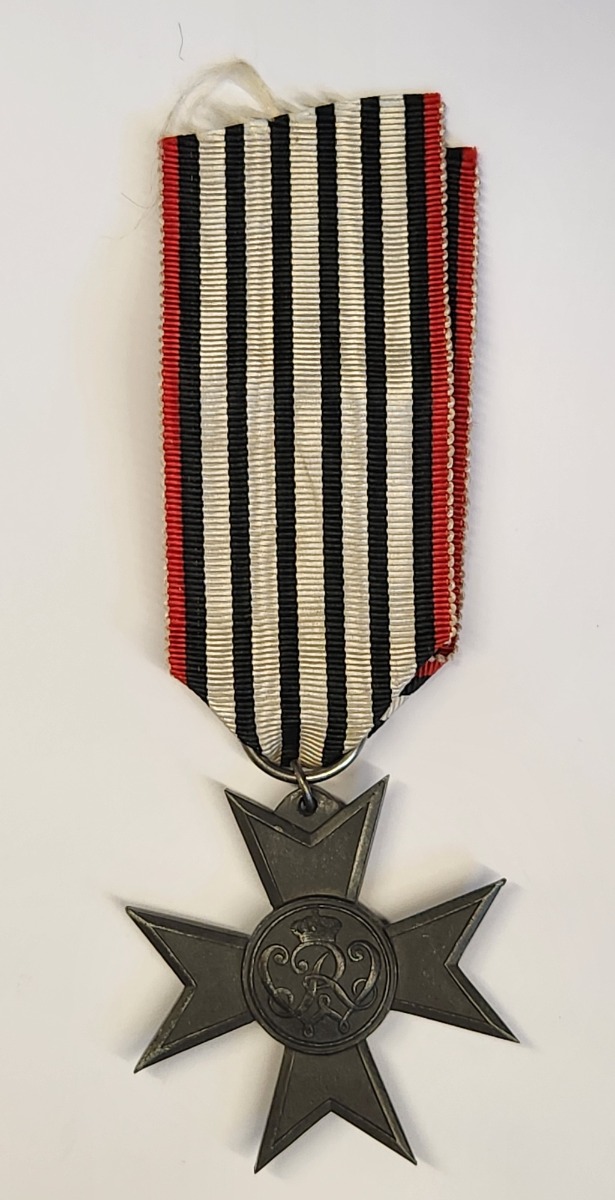GERMAN PRUSSIAN WW1 MERIT CROSS WAR AID VERDIENSTKREUZ KRIEGSHILFE MEDAL
PRUSSIAN WW1 MERIT CRROSS WAR AID MEDAL KRIEGSHILFSKREUZ, PREUSSEN - ORIGINAL
Merit Cross for War Aid (Verdienstkreuz für Kriegshilfe) was instituted on December 05, 1916 by the German emperor Wilhelm II as a decoration for military personnel and civilians regardless of their rank, social status and gender for recognition of outstanding patriotic war aid service for at least two years.
Central Powers nationals were also eligible for award according to the statute of the Cross.
A history behind an institution of Verdienstkreuz für Kriegshilfe is as follows: Prior to December 1916 Prussian subjects who distinguished themselves on a civil service could have been awarded one of the following awards: Order of the Crown (Kronenorden), 3rd and 4th Classes; Gold or Silver Merits Cross (Verdienstkreuz in Gold / Silber); General Honour Award Cross (Kreuz des Allgemeinen Ehrenzeichens); General Honour Award (Allgemeines Ehrenzeichen).
Yet value of those orders could have been depreciated in the event of mass decorations of selfless home front workers due to the protracted course of war. Incidentally the same reason restrained German authorities from mass issuance of Iron Cross, 2nd Class on non-combatants ribbon to that category of Prussian subjects.
That framework led Prussian state ministry (Preußisches Staatsministerium) being a supreme governmental body of that time to advice Wilhelm II to extend statute of the Silver Merits Cross (Verdienstkreuz in Silber) and confer it on distinguished home front workers.
Initial positive account of the Emperor had been shortly changed as he tried to avoid undesirable burden to the state treasury in case of mass production of a silver decoration in difficult times of war. Thus a decision was made in favour of a comparatively cheap award made of zinc alloy, i.e. Kriegsmetall.
Design of a new decoration was based on a Silver Merits Cross with an exception of central medallion on reverse (both sides of the latter were identical) and ribbon colour. An order was placed with the Nürnberg-based company Lauer as soon as Wilhelm II approved floating sketch. Specimen crosses were submitted for imperial approval on December 26, 1915 and first 200 pieces were then ordered for immediate production and further distribution among distinguished Prussians.
A special emphasis was made on luxury casing (brown leather boxes) for half of that lot reserved for dignitaries. The very first recipients of Verdienstkreuz für Kriegshilfe were Wilhelm II himself and Generalfeldmarschall Paul von Hindenburg. Altogether 500,000 crosses and 167,643 m of ribbon worth 857,000 Marks were ordered.
Verdienstkreuz für Kriegshilfe was generally awarded to non-combatants (signal, train and other logistics units personnel), medics and orderlies. As per civilians Merit Cross for War Aid was issued mainly to various authorities, officials, personnel of military registration and enlistment offices, etc. In compliance with its statute a Cross could have been awarded alongside with Iron Cross and other war decorations.
Verdienstkreuz für Kriegshilfe remained in the family of a recipient after his demise and was not to be surrendered. Verdienstkreuz für Kriegshilfe had a shape of equilateral eight-pointed cross 41,5x41,5 mm with raised edges and a superimposed central circular medallion. An obverse had an inscription in three rows “For Auxiliary Service in War” (“Für Kriegs Hilfsdienst”) in capital letters and two oak leaves tied by a ribbon at the bottom. A reverse had interwined letters “WR” standing for “Wilhelmus Rex” surmounted by the Prussian crown. Nürnberg-based company Lauer (Firma Lauer) was a major official manufacturer of a decoration.
As per Institution Order signed by Wilhelm II on December 05, 1916 Verdienstkreuz für Kriegshilfe was made of zinc alloy (“Kriegsmetall”) and directly of zinc. Pieces for private purchase were produced by other manufacturers of silver, aluminum and Buntmetall, a yellow colour alloy of nonferrous metals. Miniatures of Verdienstkreuz für Kriegshilfe were manufactured as well.
Merit Cross for War Aid was worn suspended from a silk white ribbon with six vertical thin black stripes and two red at its edges. Like Prussian Iron Cross 2nd Class and several other war decorations it could be worn in the traditional style, i.e. passed through the second buttonhole of a tunic.
Women recipients wore an award on a bow. Ribbons were produced by a Berlin-based company Knoblauch.
Verdienstkreuz für Kriegshilfe was awarded in 1916-1924, even after the end of the Great War. The remaining 44,250 pieces together with 15,511 m of ribbon were sold to Berlin-based company “Neue Berliner Messingwerke” in 1924.
| SKU | O607 |
|---|---|
| Weight | 0.101000 |


